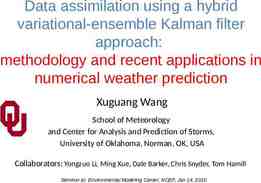Office of Student Financial Aid Montgomery College
43 Slides9.86 MB
Office of Student Financial Aid Montgomery College
What is Financial Aid? Cost of Attendance Expected Family Contribution Determining Financial Need Types and Sources of Financial Aid Financial Aid Process (FAFSA & Worksheet) Follow-up Steps/Resources Questions & Answers
Funds provided to students and families to help pay for postsecondary educational expenses Distributed limited resources in an equitable manner (gift aid & self-help aid)
Tuition and fees Room and board Books and supplies Transportation Miscellaneous personal expenses Costs vary widely from college to college
Index used to determine federal student aid eligibility Calculated using data from a federal application form (FAFSA) and a federal methodology Stays the same regardless of educational institution
Cost of Attendance (COA) - Expected Family Contribution (EFC) Financial Need
Private 4-year COA 48,710 - EFC 12,000 Need 36,710 Public 4-year COA 28,070 - EFC 12,000 Need 16,070 Public 2-year COA 19,144 - EFC 12,000 Need 7,144
Money that does not have to be paid back Usually awarded on the basis of financial need
Money that does not have to be paid back Awarded on the basis of merit, skill or unique characteristic May also be awarded on basis of need
Program provides students with employment Earned while attending school Employment assignment can be on or off campus Money does not have to be repaid
Money students and parents borrow to help pay postsecondary educational expenses Repayment usually begins after education is completed or when enrollment falls below required enrollment status Only borrow what is needed
Responsible Borrowing 13
Largest source of financial aid Aid awarded primarily on the basis of need Complete the Free Application for Federal Student Aid (FAFSA) For the 2018-2019 academic year, the FAFSA became available October 1, 2017 For the 2019-2020 academic year, the FAFSA will be available October 1, 2018 FAFSA must be renewed every year the student is enrolled
Basic Eligibility Requirements: Be a U.S. citizen or eligible non-citizen Have a valid Social Security number Comply with Selective Service registration, if required Have a high school diploma/GED/approved homeschooled program Be working toward a degree or certificate in an eligible program at a school that participates in the federal student aid programs Maintain satisfactory academic progress once enrolled
Federal Pell Grant Federal Supplemental Educational Opportunity Grant Teacher Education Assistance for College & Higher Education Grant Iraq and Afghanistan Service Grant Federal Work-Study Federal Direct Loans (Stafford Subsidized & Unsubsidized) Direct PLUS Loan
Subsidized Stafford (need-based) Unsubsidized Stafford (not need-based) Interest rates based on 10-year Treasury Note Cap on future interest rates of 8.25% Current interest rate – 4.45% (2017-2018) 6-month grace period, repayment period varies from 10-25 years
Annual borrowing limits Lifetime limit on Direct Subsidized Loans: (150% of published length of program)
Residency requirements Awards based on need and merit Deadlines vary by state; check paper FAFSA or FAFSA on the Web Information on FAFSA used to determine eligibility Follow-up with state agency to accept awards, complete state applications and turn in additional requested documents
Maryland Higher Education Commission State deadline: March 1st Maryland has financial aid programs based on financial need, merit and career track State aid may be used at public and private colleges/universities primarily in MD
Unique Major Funds awarded for the Senatorial and Delegate scholarships may be used at an out-of-state institution only if the student’s academic program is not offered at a Maryland institution Review website for more information on how to apply www.mhec.state.md.us/financialaid
Colleges/universities offer their own grants and scholarships Need-based and merit-based programs Academic, athletic and other talent-based scholarships are available Institutional aid may be awarded for freshman year only or renewable for subsequent years Contact the school’s financial aid office during the fall for applications and deadlines UNIVERSITY
Private businesses Political and advocacy organizations Religious and social organizations Parent and student’s place of employment Foundations Unions Deadlines and application procedures vary widely Begin researching private aid early!!!
Scholarship Books Career Center Public libraries Internet Scholarship Searches Provide a student profile Receive scholarship information Contact scholarship providers directly Scholarship Websites www.collegeboard.com/paying www.fastweb.com www.careerinfonet.org/scholarshipsearch www.finaid.org
FAFSA4caster FSA ID FAFSA Worksheet SAR Verification Follow-up
Get information about financial aid programs Apply for a Federal Student FSA ID (student and parent) Collect financial documents to complete FAFSA (2016 income tax return,W-2 form and other records of income) FAFSA4caster – www.studentaid.ed.gov/sa/fafsa/estimate Early estimate of EFC FAFSA on the Web Worksheet
Benefits to completing FAFSA electronically: Built-in edits to prevent errors Skip logic in order to skip unnecessary questions Detailed instructions and “Help and Hints” for common questions Timely submission of application and necessary corrections Use the IRS Data Retrieval Tool to securely transfer IRS tax information into the FAFSA
Tool that allows transfer of tax information directly from IRS website to FAFSA Benefits: It’s the easiest way to provide your tax data It’s the best way of ensuring that your FAFSA has accurate tax information You won’t need to provide a copy of your or your parents’ tax transcripts to your college
Receive a Student Aid Report (SAR) SAR contains EFC Review SAR and make corrections if needed Use FSA ID to make corrections Corrections to estimated income Add/delete school codes Follow-up with schools Verification process Additional applications and documents may be required Communicate special circumstances to institutions
Financial aid application service of The College Board Used to award private grants and scholarships 25 initial / 16 each additional report Check for a listing of participating institutions/scholarship programs www.collegeboard.com
SAP – Satisfactory Academic Progress You must maintain a successful pace of 67% Keep your cumulative GPA above 2.00 Reviewed annually after spring semester View the SAP policy on MyMC. Choose the Financial Aid tab. View under general information. 35
Federal Regulations require schools to only pay for the cost of courses in your declared program of study. Federal Financial Aid affected by this regulation includes Pell, SEOG and Teach grants, Federal Direct Stafford and Plus loans & Work-Study program. Currently this regulation does not apply to state or privately funded scholarships.
Financial aid forms and applications are just like homework; you have to turn them in correctly and on time Keep track of all financial aid deadlines State deadlines College/university deadlines Scholarship deadlines
Filling out the FAFSA is free!!! Avoid scholarship scams Don’t pay for help to find money for college Check with the Better Business Bureau about legitimacy of financial aid consultants or scholarship search services
Financial Aid TV - Montgomery College Resource videos about financial aid Generic and MC specific videos Inquire about FA TV at other institutions http:// montgomerycollege.financialaidtv.com
High school career center Prospective college/university financial aid office Department of Education Federal Student Aid Information Center 1-800-4-FED-AID Student Aid on the Web – www.StudentAid.gov
Facebook - @FinancialAidMC Instagram - @FinancialAidMC Twitter - @FinancialAidMC
















































